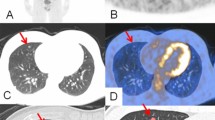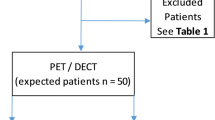Abstract
For optimal image fusion between CT and F-18-FDG-PET, the acquisition of CT images is performed in mild expiratory suspension, which might compromise the detection of lung metastases. This study aimed at evaluating the influence of expiration on the detection of solitary pulmonary nodules (SPN) and at assessing if additional inspiratory low-dose CT (I-LDCT) of the chest can improve the detection of potential lung metastases performing whole-body 16-channel PET-CT. Sixty-six patients with malignant tumors underwent PET-CT: contrast-enhanced CT was acquired during mild expiration and was used for fusion with PET images; additionally, chest I-LDCT was performed at deep inspiration. Two radiologists reported all SPN detected at I-LDCT and the expiratory CT scan independently. Overall, 53% of 128 SPN (mean: 3.8±0.2 mm) were detected at both respiratory states: 51 SPN only at I-LDCT, and 9 nodules only at expiratory CT. Of the SPN, 117/128 were classified as certain; 45 of those were additionally detected at I-LDCT, and 6 nodules at expiratory CT. A 100% detection rate was reached in SPN >4 mm at I-LDCT versus >8 mm at expiratory CT (all P<0.001). Additional I-LDCT of the chest significantly improves the detection of SPN at whole-body F-18-FDG-PET-CT and thus is recommended as part of the standard protocol for oncological patients.




Similar content being viewed by others
References
Antoch G, Saoudi N, Kuehl H, et al (2004) Accuracy of whole-body dual-modality Fluorine-18-2-Fluoro-2-deoxy-D-Glucose positron emission tomography and computed tomography (FDG-PET/CT) for tumor staging in solid tumors: comparison with CT and PET. J Clin Oncol 22:4357–4368
Lardinois D, Weder W, Hany TF, et al (2003) Staging of non-small-cell lung cancer with integrated positron-emission tomography and computed tomography. N Engl J Med 348:2500–2507
Antoch G, Vogt FM, Freudenberg LS, et al (2003) Whole-body dual-modality PET-CT and whole-body MRI for tumor staging in oncology. JAMA 290:3199–3206
Rusinek H, Naidich DP, McGuinness G, et al (1998) Pulmonary nodule detection: low-dose versus conventional CT. Radiology 209:243–249
Diederich S, Semik M, Lentschig MG, et al (1999) Helical CT of pulmonary nodules in patients with extrathoracic malignancy: CT-surgical correlation. AJR Am J Roentgenol 172:353–360
Seemann MD, Seemann O, Luboldt W, et al (2000) Differentiation of malignant from benign solitary pulmonary lesions using chest radiography, spiral CT and HRCT. Lung Cancer 29:105–124
Kozuka T, Johkoh T, Hamada S, et al (2003) Detection of pulmonary metastases with multi-detector row CT scans of 5-mm nominal section thickness: autopsy lung study. Radiology 226:231–234
Wormanns D, Kohl G, Klotz E, et al (2004) Volumetric measurements of pulmonary nodules at multi-row detector CT: in vivo reproducibility. Eur Radiol 14:86–92
Marten K, Grillhösl A, Seyfarth T, Obenauer S, Rummeny EJ, Engelke C (2005) Computer-assisted detection of pulmonary nodules: evaluation of diagnostic performance using an expert knowledge-based detection system with variable reconstruction slice thickness settings. Eur Radiol 15:203–212
Diederich S, Hansen J, Wormanns D (2005) Resolving small pulmonary nodules: CT features. Eur Radiol 15:2064–2069
Valencia R, Denecke T, Lehmkuhl L, Fischbach F, Felix R, Knollmann F. Value of axial and coronal maximum intensity projection (MIP) images in the detection of pulmonary nodules by multislice spiral CT: comparison with axial 1-mm and 5-mm slices. Eur Radiol 2005; DOI 10.1007/s00330-005-2871-1
Beyer T, Antoch G, Blodgett T, Freudenberg LF, Akhurst T, Mueller S (2003) Dual-modality PET/CT imaging: the effect of respiratory motion on combined image quality in clinical oncology. Eur J Nucl Med Mol Imaging 30:588–596
Diederich S, Wormanns D, Semik M, et al (2002) Screening for early lung cancer with low-dose spiral CT: prevalence in 817 asymptomatic smokers. Radiology 222:773–781
Townsend DW, Beyer T, Blodgett TM (2003) PET/CT scanner: a hardware approach to image fusion. Semin Nucl Med 33:193–204
Beyer T, Townsend D (2001) Dual-modality PET/CT imaging: CT based attenuation correction in the presence of CT contrast agent. J Nucl Med 42:56P
Keidar Z, Haim N, Guralnik L, et al (2004) PET/CT using 18F-FDG in suspected lung cancer recurrence: diagnostic value and impact on patient management. J Nucl Med 45:1640–1646
Gutzeit A, Antoch G, Kühl H, et al (2005) Unknown primary tumors: detection with dual-modality PET/CT - initial experience. Radiology 234:227–234
Snyder BJ, Pugatch RD (1998) Imaging characteristics of metastatic disease to the chest. Chest Surg Clin N Am 8:29–48
Davis SD (1991) CT evaluation for pulmonary metastases in patients with extrathoracic malignancy. Radiology 180:1–12
American College of Radiology. ACR appropriateness criteria: screening for pulmonary metastases: http://www.acr.org/s_acr/bin.asp?CID=1203&DID=11822&DOC=FILE.PDF
Yankelevitz DF, Henschke CI (1997) Does 2-year stability imply that pulmonary nodules are benign? Am J Roentgenol 168:325–328
Aoki T, Nakata H, Watanabe H, et al (2000) Evolution of peripheral lung adenocarcinomas: CT findings correlated with histology and tumor doubling time. AJR Am J Roentgenol 174:763–768
Yankelevitz DF, Reeves AP, Kostis WJ, Zhao B, Henschke CI (2000) Small pulmonary nodules: volumetrically determined growth rates based on CT evaluation. Radiology 217:251–256
Wormanns D, Ludwig K, Beyer F, Heindel W, Diederich S (2005) Detection of pulmonary nodules at multirow-detector CT: effectiveness of double reading to improve sensitivity at standard-dose and low-dose chest CT. Eur Radiol 15:14–22
Gould MK, Maclean CC, Kuschner WG, Rydzak CE, Owens DK (2001) Accuracy of positron emission tomography for diagnosis of pulmonary nodules and mass lesions: a meta-analysis. JAMA 285:914–924
Antoch G, Stattaus J, Nemat AT, et al (2003) Non-small cell lung cancer: dual-modality PET/CT in preoperative staging. Radiology 229:526–533
Lindell RM, Hartman TE, Swensen SJ, et al (2005) Lung cancer screening experience: A retrospective review of PET in 22 non-small cell lung carcinomas detected on screening chest CT in a high-risk population. AJR Am J Roentgenol 185:126–131
Acknowledgements
The authors are indebted to Ms. C. Schreiber and Ms. A. Brunegraf for their skilled technical assistance.
Author information
Authors and Affiliations
Corresponding author
Rights and permissions
About this article
Cite this article
Juergens, K.U., Weckesser, M., Stegger, L. et al. Tumor staging using whole-body high-resolution 16-channel PET-CT: does additional low-dose chest CT in inspiration improve the detection of solitary pulmonary nodules?. Eur Radiol 16, 1131–1137 (2006). https://doi.org/10.1007/s00330-005-0080-6
Received:
Revised:
Accepted:
Published:
Issue Date:
DOI: https://doi.org/10.1007/s00330-005-0080-6




